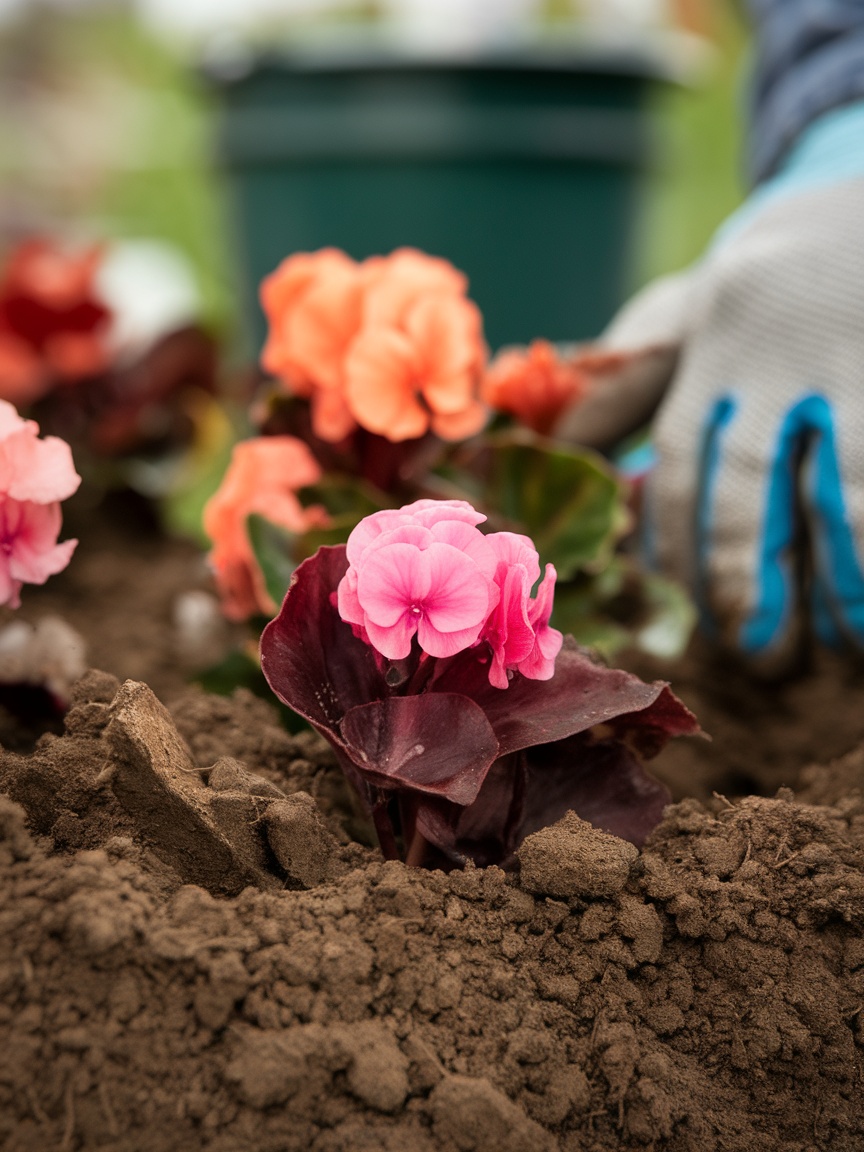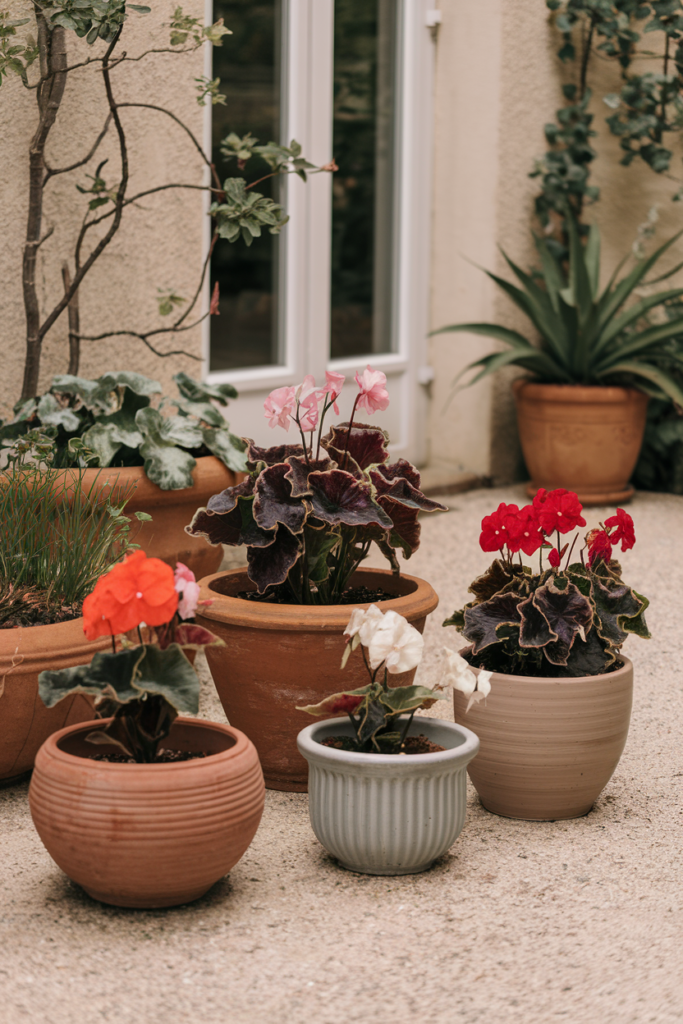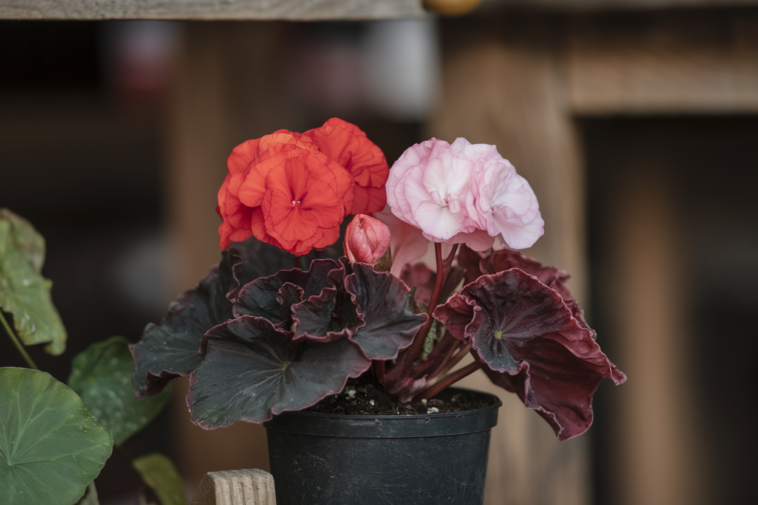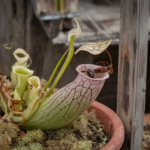If you’re looking to grow beautiful begonias in pots, you’re in the right place! These charming plants thrive in containers and can brighten up any patio or balcony. Let’s break down the essentials for planting, caring for, and enjoying your begonias, keeping it simple and fun.
Soil Requirements for Healthy Growth

Begonias thrive in well-draining soil. The image shows a person gently working with the soil around beautiful pink begonias, highlighting the connection between healthy soil and vibrant plants. This interaction is essential for their growth.
Using a mix that contains peat moss, perlite, and compost can create a perfect environment. Such a blend retains moisture while allowing excess water to escape, preventing root rot.
Make sure the soil is slightly acidic, with a pH level around 6.0 to 6.5. Testing your soil can help you achieve this balance. When planting, be careful not to bury the stems. This keeps the roots healthy and helps the plant flourish.
Regularly refreshing the top layer of soil with organic matter can also provide the nutrients begonias need. This simple step helps maintain soil health, which directly impacts your plants’ growth and blooming.
Fertilizing Schedule for Thriving Begonias
Begonias are beautiful plants that can brighten up any space. To keep them healthy and vibrant, a solid fertilizing schedule is key. In the image, we see a person about to sprinkle fertilizer onto a colorful pot of begonias. The flowers, with their bright pink and orange hues, showcase why these plants are so popular.
When it comes to fertilizing begonias, timing is everything. Start fertilizing in early spring when the growth begins. Use a balanced, water-soluble fertilizer, and follow the directions on the package. Generally, feeding every two to four weeks during the growing season is a good rule of thumb.
As the season progresses, monitor your plants. If the leaves start to yellow or the blooms seem sparse, it might be time for another dose of nutrients. Always ensure you water your begonias after fertilizing to help them absorb the nutrients better.
Remember, fertilizing is just one part of caring for your begonias. Regular watering and proper light conditions will also contribute to their overall health. Keeping an eye on your plants will help them flourish beautifully!
Watering Techniques for Potted Begonias
Watering potted begonias is simpler than it seems. The image shows a hand watering begonias with a stylish watering can, creating a refreshing scene. These beautiful, vibrant flowers thrive with proper care, especially when it comes to hydration.
Begonias like their soil to be moist but not soggy. A good rule is to check the top inch of the soil. If it feels dry, it’s time to water. Use a watering can with a spout to direct water precisely at the base of the plant. This method prevents water from splashing on the leaves, which can lead to fungal issues.
In warm weather, you might need to water more frequently. On the other hand, during cooler months, reduce watering to avoid root rot. Always remember that begonias prefer a bit of humidity, so misting the leaves occasionally can help keep them happy.
Optimal Light Conditions for Indoor and Outdoor Begonias

Begonias love light, but they don’t want to be in direct sunlight all day. The image shows a bright and cozy setup with begonias basking in natural light. The plants, with their lovely leaves and colorful blooms, clearly thrive in this environment.
For indoor begonias, place them near a window that receives bright, indirect light. This helps them grow without getting scorched. If the sunlight is too harsh, consider using sheer curtains to filter it.
When it comes to outdoor begonias, they enjoy partial shade. A spot that gets morning sun and afternoon shade works great. This keeps the plants happy and healthy, allowing them to flourish.
Dealing with Pests and Diseases in Potted Begonias
Potted begonias can be a delightful addition to your home, showcasing stunning colors and unique leaf shapes. However, like any plant, they can attract pests and diseases that threaten their beauty and health.
Common pests include aphids, mealybugs, and spider mites. These tiny invaders can cause significant damage if not controlled. Look for signs like sticky residue on leaves or webbing. If you spot them, try washing the leaves with a gentle stream of water or using insecticidal soap to help eliminate the pests.
Diseases can also affect your begonias. Fungal infections may show up as brown spots on leaves or wilting stems. To prevent these issues, ensure your plants have good air circulation and avoid overwatering. Always remove any dead or damaged leaves to keep your begonias healthy.
Regular checks on your plants can help catch problems early. A little attention goes a long way in keeping your begonias thriving!
Choosing the Right Pot for Begonias

When it comes to growing begonias in pots, choosing the right container is key. The image shows a vibrant display of begonias in various pots, each adding a splash of color to the garden. Different colors and sizes create a lively atmosphere, showing how pots can enhance the beauty of these flowers.
The first thing to remember is that begonias prefer pots with good drainage. This helps prevent water from sitting at the bottom, which can lead to root rot. The pots in the image have drainage holes, making them ideal for healthy plant growth.
Next, consider the size of the pot. A larger pot allows more space for the roots to spread out, which can be beneficial for the plant’s growth. The image features pots of various sizes, reminding us that begonias need enough room to flourish.
Finally, think about the material of your pot. Terracotta, plastic, and ceramic all have their benefits. Terracotta is great for air circulation, while plastic pots are lightweight and easy to manage. The colorful plastic pots shown in the picture are not only functional but also add a playful touch to your space.
Pruning and Maintenance Tips for Long-Lasting Blooms
Keeping your begonias blooming requires a bit of care, and pruning plays a big role in that. In the image, you can see someone pruning a vibrant pot of begonias. The bright red flowers stand out against the lush green leaves. This shows how healthy and well-maintained they are.
When you notice faded blooms, it’s time to trim them back. Snipping off dead flowers not only keeps the plant looking neat but also encourages new growth. Use sharp, clean scissors to make the cut as smooth as possible.
Don’t forget about the leaves! If you spot any yellowing or damaged leaves, remove them too. This helps the plant focus its energy on producing fresh blooms. Regular maintenance is key for long-lasting flowers.
Also, keep an eye on the soil. Begonias prefer well-draining soil. If your potting mix is too compact, it might be time to refresh it. This will give your plants the nutrients they need to thrive!
Conclusion
Growing begonias in pots is a rewarding way to add beauty to your outdoor or indoor spaces. By choosing the right variety, providing well-draining soil, maintaining proper watering habits, and ensuring adequate light, your begonias will flourish.
With minimal effort, you can enjoy these stunning blooms season after season. Whether you opt for tuberous, fibrous, or rhizomatous begonias, their vibrant colors and elegant foliage will make your patio or home feel like a garden paradise.


